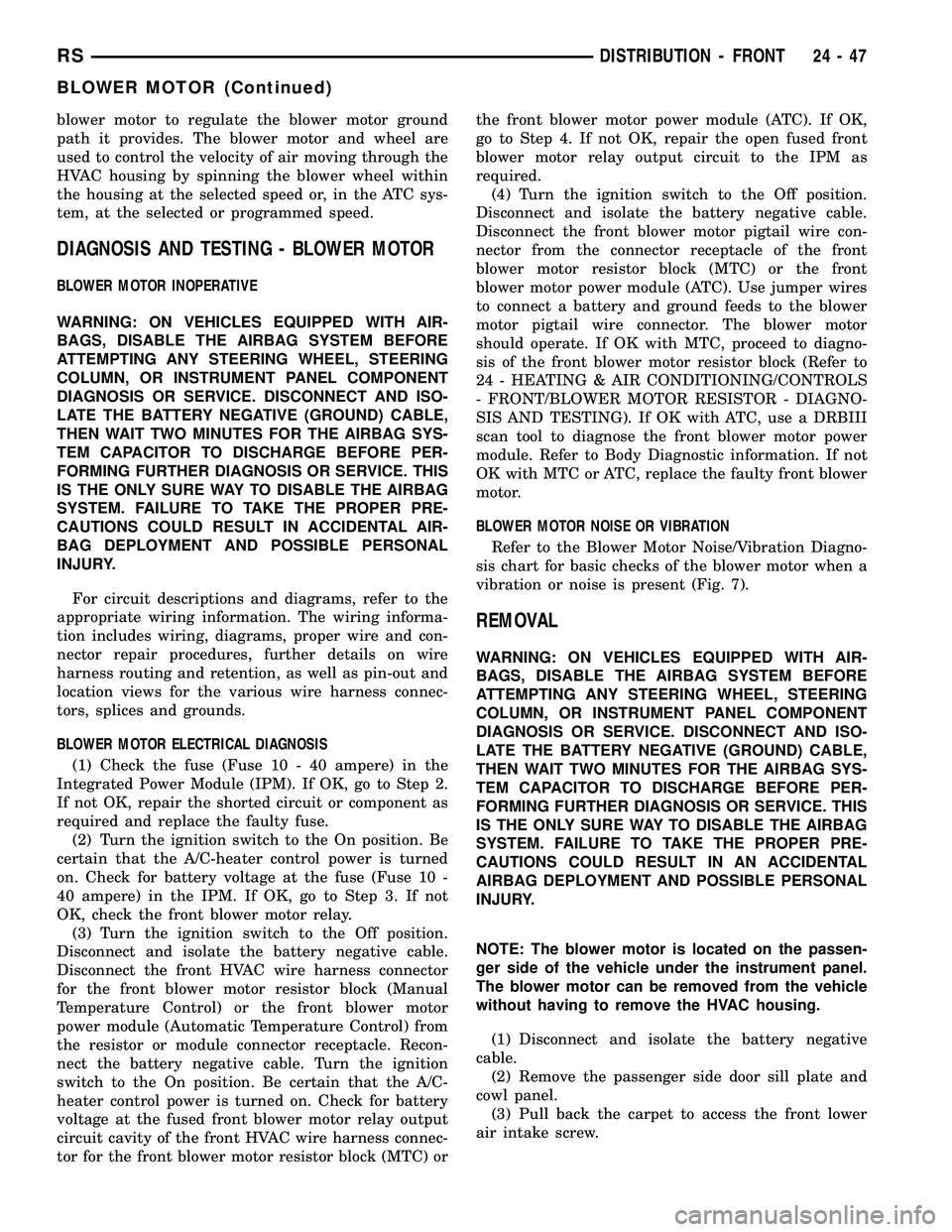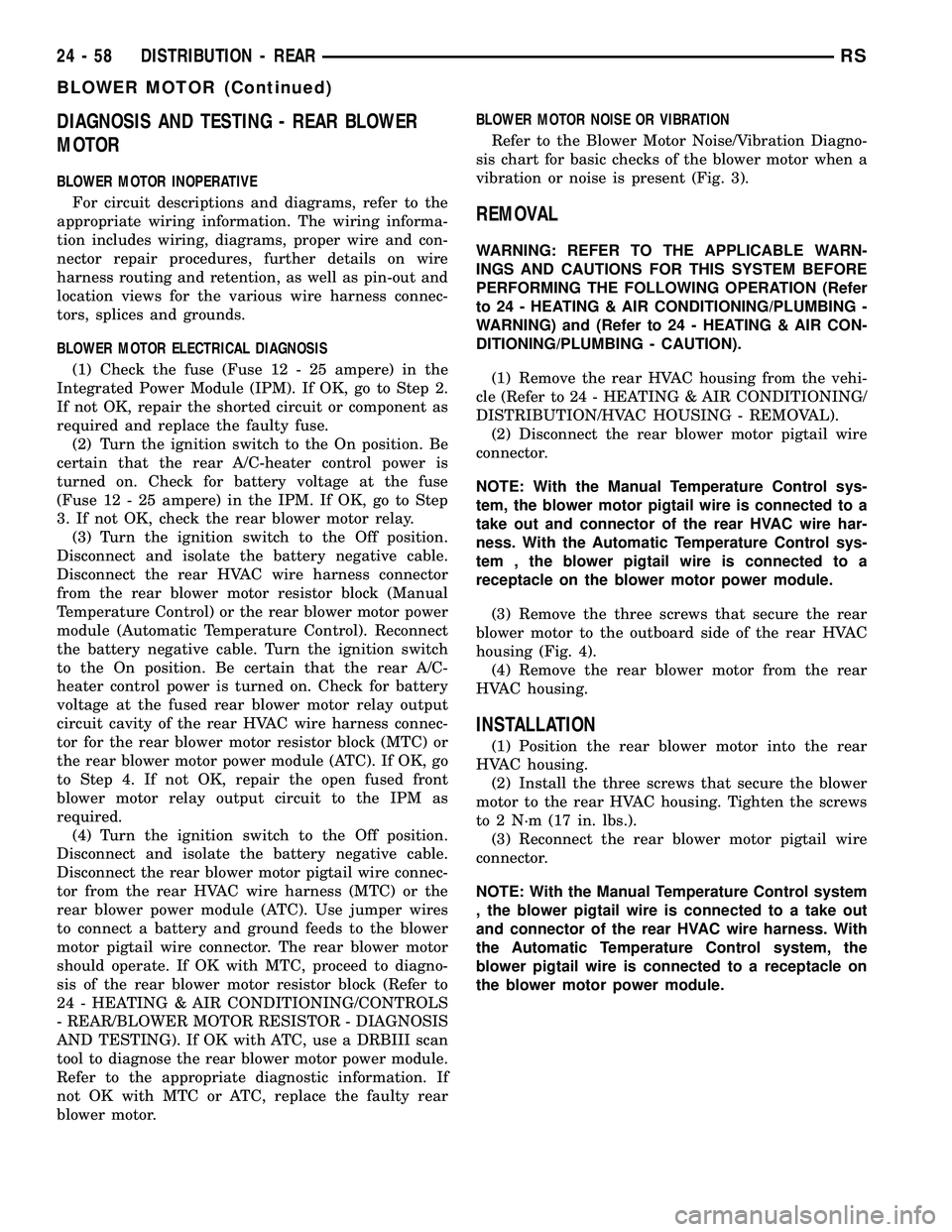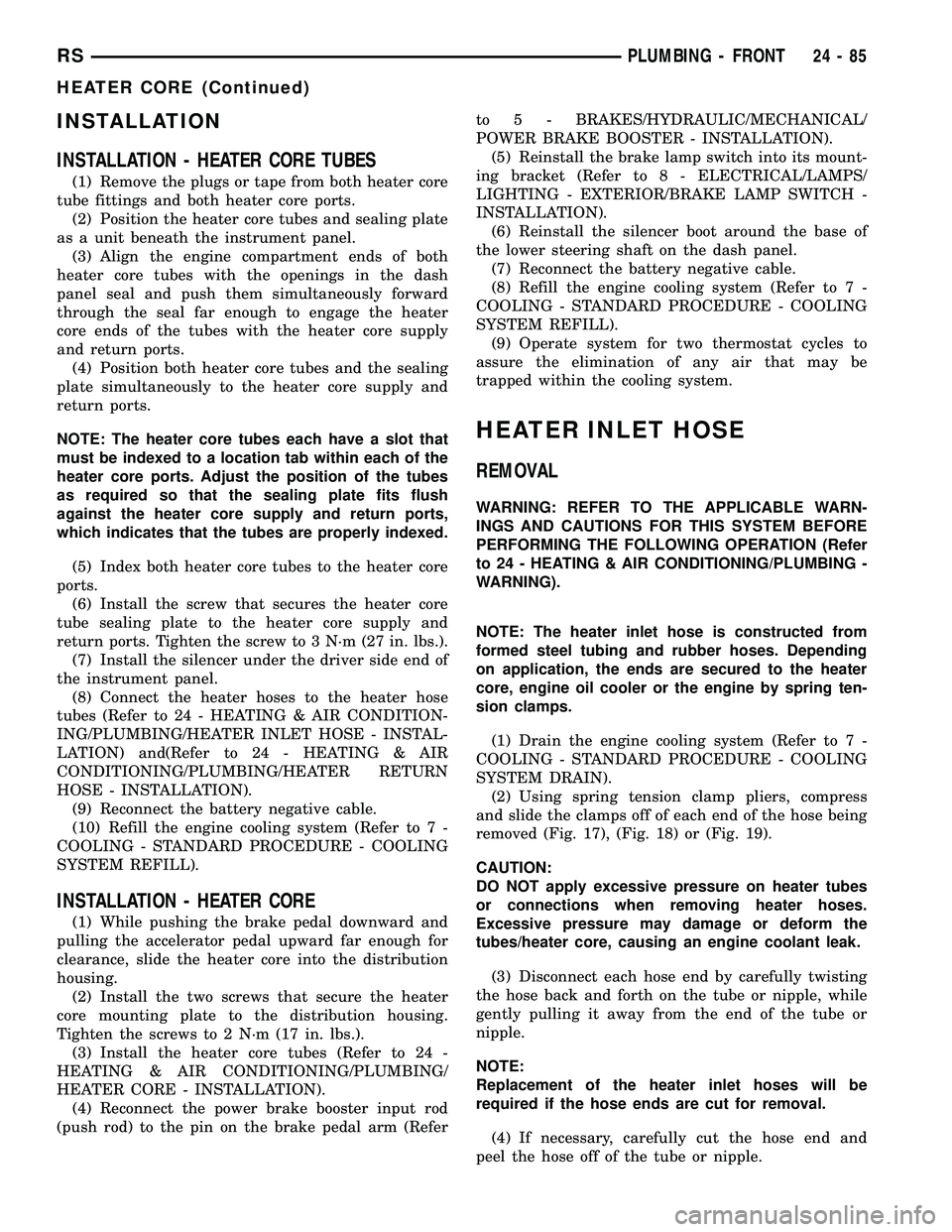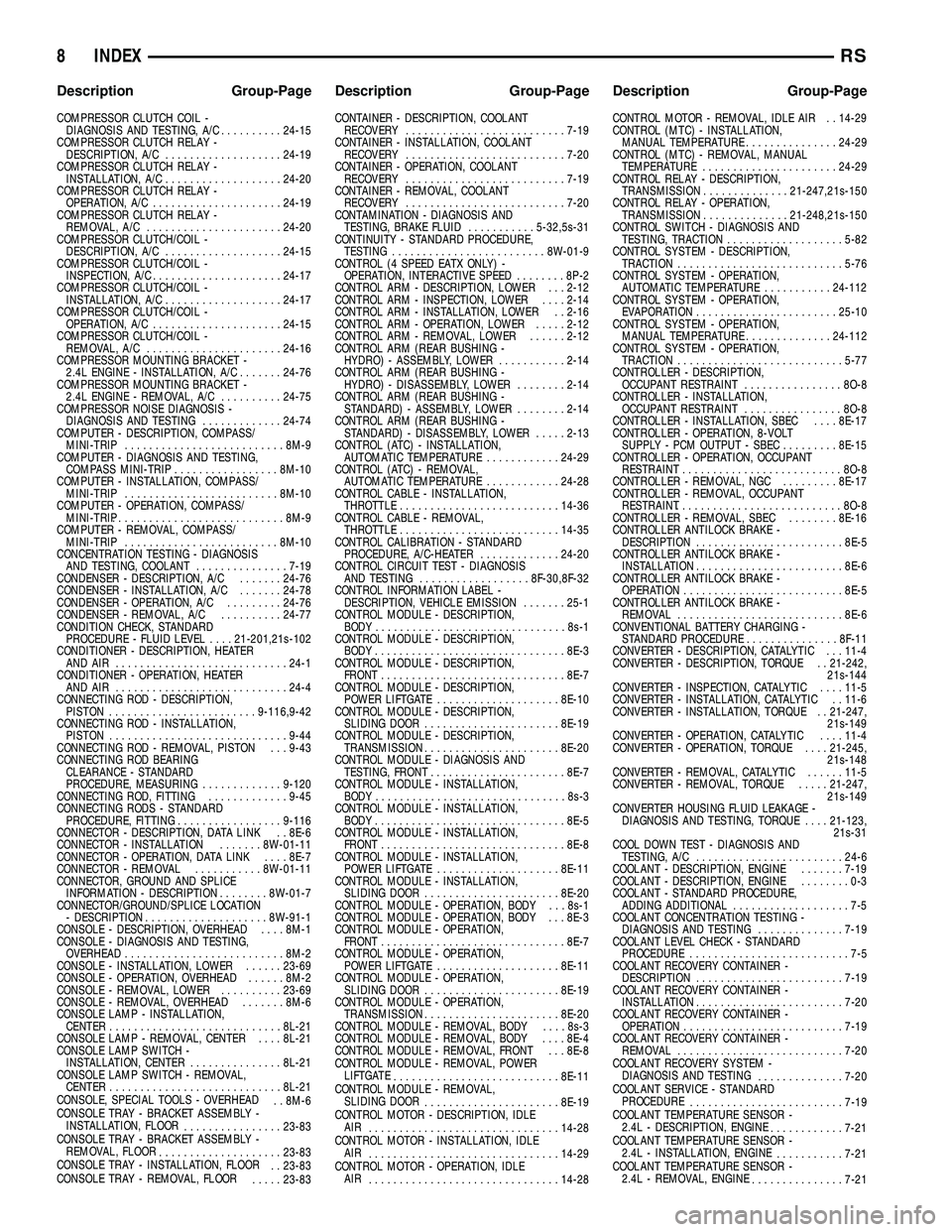2004 CHRYSLER VOYAGER battery location
[x] Cancel search: battery locationPage 2442 of 2585

blower motor to regulate the blower motor ground
path it provides. The blower motor and wheel are
used to control the velocity of air moving through the
HVAC housing by spinning the blower wheel within
the housing at the selected speed or, in the ATC sys-
tem, at the selected or programmed speed.
DIAGNOSIS AND TESTING - BLOWER MOTOR
BLOWER MOTOR INOPERATIVE
WARNING: ON VEHICLES EQUIPPED WITH AIR-
BAGS, DISABLE THE AIRBAG SYSTEM BEFORE
ATTEMPTING ANY STEERING WHEEL, STEERING
COLUMN, OR INSTRUMENT PANEL COMPONENT
DIAGNOSIS OR SERVICE. DISCONNECT AND ISO-
LATE THE BATTERY NEGATIVE (GROUND) CABLE,
THEN WAIT TWO MINUTES FOR THE AIRBAG SYS-
TEM CAPACITOR TO DISCHARGE BEFORE PER-
FORMING FURTHER DIAGNOSIS OR SERVICE. THIS
IS THE ONLY SURE WAY TO DISABLE THE AIRBAG
SYSTEM. FAILURE TO TAKE THE PROPER PRE-
CAUTIONS COULD RESULT IN ACCIDENTAL AIR-
BAG DEPLOYMENT AND POSSIBLE PERSONAL
INJURY.
For circuit descriptions and diagrams, refer to the
appropriate wiring information. The wiring informa-
tion includes wiring, diagrams, proper wire and con-
nector repair procedures, further details on wire
harness routing and retention, as well as pin-out and
location views for the various wire harness connec-
tors, splices and grounds.
BLOWER MOTOR ELECTRICAL DIAGNOSIS
(1) Check the fuse (Fuse 10 - 40 ampere) in the
Integrated Power Module (IPM). If OK, go to Step 2.
If not OK, repair the shorted circuit or component as
required and replace the faulty fuse.
(2) Turn the ignition switch to the On position. Be
certain that the A/C-heater control power is turned
on. Check for battery voltage at the fuse (Fuse 10 -
40 ampere) in the IPM. If OK, go to Step 3. If not
OK, check the front blower motor relay.
(3) Turn the ignition switch to the Off position.
Disconnect and isolate the battery negative cable.
Disconnect the front HVAC wire harness connector
for the front blower motor resistor block (Manual
Temperature Control) or the front blower motor
power module (Automatic Temperature Control) from
the resistor or module connector receptacle. Recon-
nect the battery negative cable. Turn the ignition
switch to the On position. Be certain that the A/C-
heater control power is turned on. Check for battery
voltage at the fused front blower motor relay output
circuit cavity of the front HVAC wire harness connec-
tor for the front blower motor resistor block (MTC) orthe front blower motor power module (ATC). If OK,
go to Step 4. If not OK, repair the open fused front
blower motor relay output circuit to the IPM as
required.
(4) Turn the ignition switch to the Off position.
Disconnect and isolate the battery negative cable.
Disconnect the front blower motor pigtail wire con-
nector from the connector receptacle of the front
blower motor resistor block (MTC) or the front
blower motor power module (ATC). Use jumper wires
to connect a battery and ground feeds to the blower
motor pigtail wire connector. The blower motor
should operate. If OK with MTC, proceed to diagno-
sis of the front blower motor resistor block (Refer to
24 - HEATING & AIR CONDITIONING/CONTROLS
- FRONT/BLOWER MOTOR RESISTOR - DIAGNO-
SIS AND TESTING). If OK with ATC, use a DRBIII
scan tool to diagnose the front blower motor power
module. Refer to Body Diagnostic information. If not
OK with MTC or ATC, replace the faulty front blower
motor.
BLOWER MOTOR NOISE OR VIBRATION
Refer to the Blower Motor Noise/Vibration Diagno-
sis chart for basic checks of the blower motor when a
vibration or noise is present (Fig. 7).
REMOVAL
WARNING: ON VEHICLES EQUIPPED WITH AIR-
BAGS, DISABLE THE AIRBAG SYSTEM BEFORE
ATTEMPTING ANY STEERING WHEEL, STEERING
COLUMN, OR INSTRUMENT PANEL COMPONENT
DIAGNOSIS OR SERVICE. DISCONNECT AND ISO-
LATE THE BATTERY NEGATIVE (GROUND) CABLE,
THEN WAIT TWO MINUTES FOR THE AIRBAG SYS-
TEM CAPACITOR TO DISCHARGE BEFORE PER-
FORMING FURTHER DIAGNOSIS OR SERVICE. THIS
IS THE ONLY SURE WAY TO DISABLE THE AIRBAG
SYSTEM. FAILURE TO TAKE THE PROPER PRE-
CAUTIONS COULD RESULT IN AN ACCIDENTAL
AIRBAG DEPLOYMENT AND POSSIBLE PERSONAL
INJURY.
NOTE: The blower motor is located on the passen-
ger side of the vehicle under the instrument panel.
The blower motor can be removed from the vehicle
without having to remove the HVAC housing.
(1) Disconnect and isolate the battery negative
cable.
(2) Remove the passenger side door sill plate and
cowl panel.
(3) Pull back the carpet to access the front lower
air intake screw.
RSDISTRIBUTION - FRONT24-47
BLOWER MOTOR (Continued)
Page 2453 of 2585

DIAGNOSIS AND TESTING - REAR BLOWER
MOTOR
BLOWER MOTOR INOPERATIVE
For circuit descriptions and diagrams, refer to the
appropriate wiring information. The wiring informa-
tion includes wiring, diagrams, proper wire and con-
nector repair procedures, further details on wire
harness routing and retention, as well as pin-out and
location views for the various wire harness connec-
tors, splices and grounds.
BLOWER MOTOR ELECTRICAL DIAGNOSIS
(1) Check the fuse (Fuse 12 - 25 ampere) in the
Integrated Power Module (IPM). If OK, go to Step 2.
If not OK, repair the shorted circuit or component as
required and replace the faulty fuse.
(2) Turn the ignition switch to the On position. Be
certain that the rear A/C-heater control power is
turned on. Check for battery voltage at the fuse
(Fuse 12 - 25 ampere) in the IPM. If OK, go to Step
3. If not OK, check the rear blower motor relay.
(3) Turn the ignition switch to the Off position.
Disconnect and isolate the battery negative cable.
Disconnect the rear HVAC wire harness connector
from the rear blower motor resistor block (Manual
Temperature Control) or the rear blower motor power
module (Automatic Temperature Control). Reconnect
the battery negative cable. Turn the ignition switch
to the On position. Be certain that the rear A/C-
heater control power is turned on. Check for battery
voltage at the fused rear blower motor relay output
circuit cavity of the rear HVAC wire harness connec-
tor for the rear blower motor resistor block (MTC) or
the rear blower motor power module (ATC). If OK, go
to Step 4. If not OK, repair the open fused front
blower motor relay output circuit to the IPM as
required.
(4) Turn the ignition switch to the Off position.
Disconnect and isolate the battery negative cable.
Disconnect the rear blower motor pigtail wire connec-
tor from the rear HVAC wire harness (MTC) or the
rear blower power module (ATC). Use jumper wires
to connect a battery and ground feeds to the blower
motor pigtail wire connector. The rear blower motor
should operate. If OK with MTC, proceed to diagno-
sis of the rear blower motor resistor block (Refer to
24 - HEATING & AIR CONDITIONING/CONTROLS
- REAR/BLOWER MOTOR RESISTOR - DIAGNOSIS
AND TESTING). If OK with ATC, use a DRBIII scan
tool to diagnose the rear blower motor power module.
Refer to the appropriate diagnostic information. If
not OK with MTC or ATC, replace the faulty rear
blower motor.BLOWER MOTOR NOISE OR VIBRATION
Refer to the Blower Motor Noise/Vibration Diagno-
sis chart for basic checks of the blower motor when a
vibration or noise is present (Fig. 3).
REMOVAL
WARNING: REFER TO THE APPLICABLE WARN-
INGS AND CAUTIONS FOR THIS SYSTEM BEFORE
PERFORMING THE FOLLOWING OPERATION (Refer
to 24 - HEATING & AIR CONDITIONING/PLUMBING -
WARNING) and (Refer to 24 - HEATING & AIR CON-
DITIONING/PLUMBING - CAUTION).
(1) Remove the rear HVAC housing from the vehi-
cle (Refer to 24 - HEATING & AIR CONDITIONING/
DISTRIBUTION/HVAC HOUSING - REMOVAL).
(2) Disconnect the rear blower motor pigtail wire
connector.
NOTE: With the Manual Temperature Control sys-
tem, the blower motor pigtail wire is connected to a
take out and connector of the rear HVAC wire har-
ness. With the Automatic Temperature Control sys-
tem , the blower pigtail wire is connected to a
receptacle on the blower motor power module.
(3) Remove the three screws that secure the rear
blower motor to the outboard side of the rear HVAC
housing (Fig. 4).
(4) Remove the rear blower motor from the rear
HVAC housing.
INSTALLATION
(1) Position the rear blower motor into the rear
HVAC housing.
(2) Install the three screws that secure the blower
motor to the rear HVAC housing. Tighten the screws
to 2 N´m (17 in. lbs.).
(3) Reconnect the rear blower motor pigtail wire
connector.
NOTE: With the Manual Temperature Control system
, the blower pigtail wire is connected to a take out
and connector of the rear HVAC wire harness. With
the Automatic Temperature Control system, the
blower pigtail wire is connected to a receptacle on
the blower motor power module.
24 - 58 DISTRIBUTION - REARRS
BLOWER MOTOR (Continued)
Page 2480 of 2585

INSTALLATION
INSTALLATION - HEATER CORE TUBES
(1) Remove the plugs or tape from both heater core
tube fittings and both heater core ports.
(2) Position the heater core tubes and sealing plate
as a unit beneath the instrument panel.
(3) Align the engine compartment ends of both
heater core tubes with the openings in the dash
panel seal and push them simultaneously forward
through the seal far enough to engage the heater
core ends of the tubes with the heater core supply
and return ports.
(4) Position both heater core tubes and the sealing
plate simultaneously to the heater core supply and
return ports.
NOTE: The heater core tubes each have a slot that
must be indexed to a location tab within each of the
heater core ports. Adjust the position of the tubes
as required so that the sealing plate fits flush
against the heater core supply and return ports,
which indicates that the tubes are properly indexed.
(5) Index both heater core tubes to the heater core
ports.
(6) Install the screw that secures the heater core
tube sealing plate to the heater core supply and
return ports. Tighten the screw to 3 N´m (27 in. lbs.).
(7) Install the silencer under the driver side end of
the instrument panel.
(8) Connect the heater hoses to the heater hose
tubes (Refer to 24 - HEATING & AIR CONDITION-
ING/PLUMBING/HEATER INLET HOSE - INSTAL-
LATION) and(Refer to 24 - HEATING & AIR
CONDITIONING/PLUMBING/HEATER RETURN
HOSE - INSTALLATION).
(9) Reconnect the battery negative cable.
(10) Refill the engine cooling system (Refer to 7 -
COOLING - STANDARD PROCEDURE - COOLING
SYSTEM REFILL).
INSTALLATION - HEATER CORE
(1) While pushing the brake pedal downward and
pulling the accelerator pedal upward far enough for
clearance, slide the heater core into the distribution
housing.
(2) Install the two screws that secure the heater
core mounting plate to the distribution housing.
Tighten the screws to 2 N´m (17 in. lbs.).
(3) Install the heater core tubes (Refer to 24 -
HEATING & AIR CONDITIONING/PLUMBING/
HEATER CORE - INSTALLATION).
(4) Reconnect the power brake booster input rod
(push rod) to the pin on the brake pedal arm (Referto 5 - BRAKES/HYDRAULIC/MECHANICAL/
POWER BRAKE BOOSTER - INSTALLATION).
(5) Reinstall the brake lamp switch into its mount-
ing bracket (Refer to 8 - ELECTRICAL/LAMPS/
LIGHTING - EXTERIOR/BRAKE LAMP SWITCH -
INSTALLATION).
(6) Reinstall the silencer boot around the base of
the lower steering shaft on the dash panel.
(7) Reconnect the battery negative cable.
(8) Refill the engine cooling system (Refer to 7 -
COOLING - STANDARD PROCEDURE - COOLING
SYSTEM REFILL).
(9) Operate system for two thermostat cycles to
assure the elimination of any air that may be
trapped within the cooling system.
HEATER INLET HOSE
REMOVAL
WARNING: REFER TO THE APPLICABLE WARN-
INGS AND CAUTIONS FOR THIS SYSTEM BEFORE
PERFORMING THE FOLLOWING OPERATION (Refer
to 24 - HEATING & AIR CONDITIONING/PLUMBING -
WARNING).
NOTE: The heater inlet hose is constructed from
formed steel tubing and rubber hoses. Depending
on application, the ends are secured to the heater
core, engine oil cooler or the engine by spring ten-
sion clamps.
(1) Drain the engine cooling system (Refer to 7 -
COOLING - STANDARD PROCEDURE - COOLING
SYSTEM DRAIN).
(2) Using spring tension clamp pliers, compress
and slide the clamps off of each end of the hose being
removed (Fig. 17), (Fig. 18) or (Fig. 19).
CAUTION:
DO NOT apply excessive pressure on heater tubes
or connections when removing heater hoses.
Excessive pressure may damage or deform the
tubes/heater core, causing an engine coolant leak.
(3) Disconnect each hose end by carefully twisting
the hose back and forth on the tube or nipple, while
gently pulling it away from the end of the tube or
nipple.
NOTE:
Replacement of the heater inlet hoses will be
required if the hose ends are cut for removal.
(4) If necessary, carefully cut the hose end and
peel the hose off of the tube or nipple.
RSPLUMBING - FRONT24-85
HEATER CORE (Continued)
Page 2528 of 2585

NATURAL VAC LEAK
DETECTION ASSY
REMOVAL
(1) Disconnect thew negative battery cable.
(2) Raise vehicle and support (Fig. 4).
(3) Unlock and disconnect the electrical connector.
(4) Remove the hoses from the NVLD valve.
(5) Remove the 2 fasteners.
(6) Remove the valve and bracket from vehicle
(Fig. 5).
(7) Remove valve from bracket (Fig. 6).
INSTALLATION
(1) Install NVLD valve to the bracket (Fig. 6).
(2) Install valve and bracket to the vehicle (Fig. 5).
(3) Install the 2 mounting bolts and tighten.
(4) Install the electrical connector and lock.
(5) Install the 2 hoses and lock the clamps.
(6) Lower vehicle.
LEAK DETECTION PUMP
REMOVAL
(1) Disconnect the negative battery cable.
(2) Raise and support the vehicle.
(3) Remove 3 hoses (Fig. 7).
(4) Remove the electrical connector (Fig. 8).
(5) Remove the 3 screws and remove LDP pump.
INSTALLATION
(1) Install LDP.
(2) Install the 3 screws and tighten (Fig. 8).
(3) Install the electrical connector.
(4) Install the 3 hoses (Fig. 7).
(5) Lower vehicle.
(6) Connect the negative battery cable.
Fig. 4 NVLD LOCATION
Fig. 5 NVLD REMOVAL/INSTALLATION
Fig. 6 NVLD VALVE AND BRACKET
RSEVAPORATIVE EMISSIONS25-13
Page 2551 of 2585

COMPRESSOR CLUTCH COIL -
DIAGNOSIS AND TESTING, A/C..........24-15
COMPRESSOR CLUTCH RELAY -
DESCRIPTION, A/C...................24-19
COMPRESSOR CLUTCH RELAY -
INSTALLATION, A/C...................24-20
COMPRESSOR CLUTCH RELAY -
OPERATION, A/C.....................24-19
COMPRESSOR CLUTCH RELAY -
REMOVAL, A/C......................24-20
COMPRESSOR CLUTCH/COIL -
DESCRIPTION, A/C...................24-15
COMPRESSOR CLUTCH/COIL -
INSPECTION, A/C.....................24-17
COMPRESSOR CLUTCH/COIL -
INSTALLATION, A/C...................24-17
COMPRESSOR CLUTCH/COIL -
OPERATION, A/C.....................24-15
COMPRESSOR CLUTCH/COIL -
REMOVAL, A/C......................24-16
COMPRESSOR MOUNTING BRACKET -
2.4L ENGINE - INSTALLATION, A/C.......24-76
COMPRESSOR MOUNTING BRACKET -
2.4L ENGINE - REMOVAL, A/C..........24-75
COMPRESSOR NOISE DIAGNOSIS -
DIAGNOSIS AND TESTING.............24-74
COMPUTER - DESCRIPTION, COMPASS/
MINI-TRIP..........................8M-9
COMPUTER - DIAGNOSIS AND TESTING,
COMPASS MINI-TRIP.................8M-10
COMPUTER - INSTALLATION, COMPASS/
MINI-TRIP.........................8M-10
COMPUTER - OPERATION, COMPASS/
MINI-TRIP............................8M-9
COMPUTER - REMOVAL, COMPASS/
MINI-TRIP.........................8M-10
CONCENTRATION TESTING - DIAGNOSIS
AND TESTING, COOLANT...............7-19
CONDENSER - DESCRIPTION, A/C.......24-76
CONDENSER - INSTALLATION, A/C.......24-78
CONDENSER - OPERATION, A/C.........24-76
CONDENSER - REMOVAL, A/C..........24-77
CONDITION CHECK, STANDARD
PROCEDURE - FLUID LEVEL....21-201,21s-102
CONDITIONER - DESCRIPTION, HEATER
AND AIR ............................24-1
CONDITIONER - OPERATION, HEATER
AND AIR ............................24-4
CONNECTING ROD - DESCRIPTION,
PISTON........................9-116,9-42
CONNECTING ROD - INSTALLATION,
PISTON.............................9-44
CONNECTING ROD - REMOVAL, PISTON . . . 9-43
CONNECTING ROD BEARING
CLEARANCE - STANDARD
PROCEDURE, MEASURING.............9-120
CONNECTING ROD, FITTING.............9-45
CONNECTING RODS - STANDARD
PROCEDURE, FITTING.................9-116
CONNECTOR - DESCRIPTION, DATA LINK . . 8E-6
CONNECTOR - INSTALLATION.......8W-01-11
CONNECTOR - OPERATION, DATA LINK....8E-7
CONNECTOR - REMOVAL...........8W-01-11
CONNECTOR, GROUND AND SPLICE
INFORMATION - DESCRIPTION........8W-01-7
CONNECTOR/GROUND/SPLICE LOCATION
- DESCRIPTION....................8W-91-1
CONSOLE - DESCRIPTION, OVERHEAD....8M-1
CONSOLE - DIAGNOSIS AND TESTING,
OVERHEAD..........................8M-2
CONSOLE - INSTALLATION, LOWER......23-69
CONSOLE - OPERATION, OVERHEAD......8M-2
CONSOLE - REMOVAL, LOWER..........23-69
CONSOLE - REMOVAL, OVERHEAD.......8M-6
CONSOLE LAMP - INSTALLATION,
CENTER............................8L-21
CONSOLE LAMP - REMOVAL, CENTER....8L-21
CONSOLE LAMP SWITCH -
INSTALLATION, CENTER...............8L-21
CONSOLE LAMP SWITCH - REMOVAL,
CENTER............................8L-21
CONSOLE, SPECIAL TOOLS - OVERHEAD
. . 8M-6
CONSOLE TRAY - BRACKET ASSEMBLY -
INSTALLATION, FLOOR
................23-83
CONSOLE TRAY - BRACKET ASSEMBLY -
REMOVAL, FLOOR
....................23-83
CONSOLE TRAY - INSTALLATION, FLOOR
. . 23-83
CONSOLE TRAY - REMOVAL, FLOOR
.....23-83CONTAINER - DESCRIPTION, COOLANT
RECOVERY..........................7-19
CONTAINER - INSTALLATION, COOLANT
RECOVERY..........................7-20
CONTAINER - OPERATION, COOLANT
RECOVERY..........................7-19
CONTAINER - REMOVAL, COOLANT
RECOVERY..........................7-20
CONTAMINATION - DIAGNOSIS AND
TESTING, BRAKE FLUID...........5-32,5s-31
CONTINUITY - STANDARD PROCEDURE,
TESTING.........................8W-01-9
CONTROL (4 SPEED EATX ONLY) -
OPERATION, INTERACTIVE SPEED........8P-2
CONTROL ARM - DESCRIPTION, LOWER . . . 2-12
CONTROL ARM - INSPECTION, LOWER....2-14
CONTROL ARM - INSTALLATION, LOWER . . 2-16
CONTROL ARM - OPERATION, LOWER.....2-12
CONTROL ARM - REMOVAL, LOWER......2-12
CONTROL ARM (REAR BUSHING -
HYDRO) - ASSEMBLY, LOWER...........2-14
CONTROL ARM (REAR BUSHING -
HYDRO) - DISASSEMBLY, LOWER........2-14
CONTROL ARM (REAR BUSHING -
STANDARD) - ASSEMBLY, LOWER........2-14
CONTROL ARM (REAR BUSHING -
STANDARD) - DISASSEMBLY, LOWER.....2-13
CONTROL (ATC) - INSTALLATION,
AUTOMATIC TEMPERATURE............24-29
CONTROL (ATC) - REMOVAL,
AUTOMATIC TEMPERATURE............24-28
CONTROL CABLE - INSTALLATION,
THROTTLE..........................14-36
CONTROL CABLE - REMOVAL,
THROTTLE..........................14-35
CONTROL CALIBRATION - STANDARD
PROCEDURE, A/C-HEATER.............24-20
CONTROL CIRCUIT TEST - DIAGNOSIS
AND TESTING..................8F-30,8F-32
CONTROL INFORMATION LABEL -
DESCRIPTION, VEHICLE EMISSION.......25-1
CONTROL MODULE - DESCRIPTION,
BODY...............................8s-1
CONTROL MODULE - DESCRIPTION,
BODY...............................8E-3
CONTROL MODULE - DESCRIPTION,
FRONT..............................8E-7
CONTROL MODULE - DESCRIPTION,
POWER LIFTGATE....................8E-10
CONTROL MODULE - DESCRIPTION,
SLIDING DOOR......................8E-19
CONTROL MODULE - DESCRIPTION,
TRANSMISSION......................8E-20
CONTROL MODULE - DIAGNOSIS AND
TESTING, FRONT......................8E-7
CONTROL MODULE - INSTALLATION,
BODY...............................8s-3
CONTROL MODULE - INSTALLATION,
BODY...............................8E-5
CONTROL MODULE - INSTALLATION,
FRONT..............................8E-8
CONTROL MODULE - INSTALLATION,
POWER LIFTGATE....................8E-11
CONTROL MODULE - INSTALLATION,
SLIDING DOOR......................8E-20
CONTROL MODULE - OPERATION, BODY . . . 8s-1
CONTROL MODULE - OPERATION, BODY . . . 8E-3
CONTROL MODULE - OPERATION,
FRONT..............................8E-7
CONTROL MODULE - OPERATION,
POWER LIFTGATE....................8E-11
CONTROL MODULE - OPERATION,
SLIDING DOOR......................8E-19
CONTROL MODULE - OPERATION,
TRANSMISSION......................8E-20
CONTROL MODULE - REMOVAL, BODY....8s-3
CONTROL MODULE - REMOVAL, BODY....8E-4
CONTROL MODULE - REMOVAL, FRONT . . . 8E-8
CONTROL MODULE - REMOVAL, POWER
LIFTGATE
...........................8E-11
CONTROL MODULE - REMOVAL,
SLIDING DOOR
......................8E-19
CONTROL MOTOR - DESCRIPTION, IDLE
AIR
...............................14-28
CONTROL MOTOR - INSTALLATION, IDLE
AIR
...............................14-29
CONTROL MOTOR - OPERATION, IDLE
AIR
...............................14-28CONTROL MOTOR - REMOVAL, IDLE AIR . . 14-29
CONTROL (MTC) - INSTALLATION,
MANUAL TEMPERATURE...............24-29
CONTROL (MTC) - REMOVAL, MANUAL
TEMPERATURE......................24-29
CONTROL RELAY - DESCRIPTION,
TRANSMISSION..............21-247,21s-150
CONTROL RELAY - OPERATION,
TRANSMISSION..............21-248,21s-150
CONTROL SWITCH - DIAGNOSIS AND
TESTING, TRACTION...................5-82
CONTROL SYSTEM - DESCRIPTION,
TRACTION...........................5-76
CONTROL SYSTEM - OPERATION,
AUTOMATIC TEMPERATURE...........24-112
CONTROL SYSTEM - OPERATION,
EVAPORATION.......................25-10
CONTROL SYSTEM - OPERATION,
MANUAL TEMPERATURE..............24-112
CONTROL SYSTEM - OPERATION,
TRACTION...........................5-77
CONTROLLER - DESCRIPTION,
OCCUPANT RESTRAINT................8O-8
CONTROLLER - INSTALLATION,
OCCUPANT RESTRAINT................8O-8
CONTROLLER - INSTALLATION, SBEC....8E-17
CONTROLLER - OPERATION, 8-VOLT
SUPPLY - PCM OUTPUT - SBEC.........8E-15
CONTROLLER - OPERATION, OCCUPANT
RESTRAINT..........................8O-8
CONTROLLER - REMOVAL, NGC.........8E-17
CONTROLLER - REMOVAL, OCCUPANT
RESTRAINT...........................8O-8
CONTROLLER - REMOVAL, SBEC........8E-16
CONTROLLER ANTILOCK BRAKE -
DESCRIPTION........................8E-5
CONTROLLER ANTILOCK BRAKE -
INSTALLATION........................8E-6
CONTROLLER ANTILOCK BRAKE -
OPERATION..........................8E-5
CONTROLLER ANTILOCK BRAKE -
REMOVAL...........................8E-6
CONVENTIONAL BATTERY CHARGING -
STANDARD PROCEDURE...............8F-11
CONVERTER - DESCRIPTION, CATALYTIC . . . 11-4
CONVERTER - DESCRIPTION, TORQUE . . 21-242,
21s-144
CONVERTER - INSPECTION, CATALYTIC....11-5
CONVERTER - INSTALLATION, CATALYTIC . . 11-6
CONVERTER - INSTALLATION, TORQUE . . 21-247,
21s-149
CONVERTER - OPERATION, CATALYTIC....11-4
CONVERTER - OPERATION, TORQUE....21-245,
21s-148
CONVERTER - REMOVAL, CATALYTIC......11-5
CONVERTER - REMOVAL, TORQUE.....21-247,
21s-149
CONVERTER HOUSING FLUID LEAKAGE -
DIAGNOSIS AND TESTING, TORQUE....21-123,
21s-31
COOL DOWN TEST - DIAGNOSIS AND
TESTING, A/C........................24-6
COOLANT - DESCRIPTION, ENGINE.......7-19
COOLANT - DESCRIPTION, ENGINE........0-3
COOLANT - STANDARD PROCEDURE,
ADDING ADDITIONAL...................7-5
COOLANT CONCENTRATION TESTING -
DIAGNOSIS AND TESTING..............7-19
COOLANT LEVEL CHECK - STANDARD
PROCEDURE..........................7-5
COOLANT RECOVERY CONTAINER -
DESCRIPTION........................7-19
COOLANT RECOVERY CONTAINER -
INSTALLATION........................7-20
COOLANT RECOVERY CONTAINER -
OPERATION..........................7-19
COOLANT RECOVERY CONTAINER -
REMOVAL...........................7-20
COOLANT RECOVERY SYSTEM -
DIAGNOSIS AND TESTING
..............7-20
COOLANT SERVICE - STANDARD
PROCEDURE
.........................7-19
COOLANT TEMPERATURE SENSOR -
2.4L - DESCRIPTION, ENGINE
............7-21
COOLANT TEMPERATURE SENSOR -
2.4L - INSTALLATION, ENGINE
...........7-21
COOLANT TEMPERATURE SENSOR -
2.4L - REMOVAL, ENGINE
...............7-21
8 INDEXRS
Description Group-Page Description Group-Page Description Group-Page